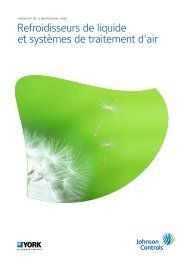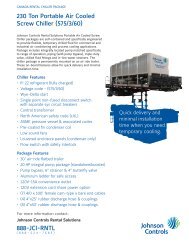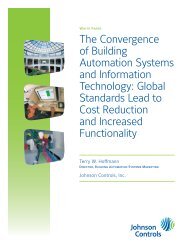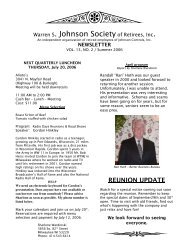Rxf - Johnson Controls Inc.
Rxf - Johnson Controls Inc.
Rxf - Johnson Controls Inc.
Create successful ePaper yourself
Turn your PDF publications into a flip-book with our unique Google optimized e-Paper software.
4. Welding should occur in two segments, from 6:00 to 12:00.<br />
The maximum intersegment temperature should be 350°F.<br />
Temperature should be verified with temperature indicating<br />
crayon or equivalent.<br />
5. The fitting may be cooled with forced air to reduce the<br />
temperature of the fitting to 350°F or lower, prior to welding<br />
the second segment.<br />
The maximum connection static forces and moments for Alfa<br />
Nova heat exchangers are listed in the following table.Keep<br />
these values in mind when designing your system. It is also<br />
recommended to minimize connection loads when designing<br />
piping systems. Also see Figure 6.<br />
.<br />
Fx Fy Fz Mx My Mz<br />
(lbf) (lbf) (lbf) (lbfft) (lbfft) (lbfft) ANHP52 202 13 13 57 32 32<br />
ANHP76 292 22 22 103 58 58<br />
Figure 5 - Application of heat-sink paste before welding<br />
Figure 6 - Maximum static forces and moments<br />
LIQUID INJECTION OIL COOLING<br />
The liquid injection system provided on the unit is self-contained<br />
but requires the connection of the liquid line sized as<br />
shown in the table.<br />
RXF ROTARY SCREW COMPRESSOR UNITS<br />
INSTALLATION<br />
070.410-IOM (JUL 11)<br />
Page 9<br />
Liquid line sizes and the additional receiver volume (quantity<br />
of refrigerant required for 5 minutes of liquid injection oil<br />
cooling) are given in the following table:<br />
RXF LIQ. LINE SIZE*<br />
FLOW<br />
RATE LIQUID<br />
REFRIg MODEL PIPE TUBINg (lb) VOLUME<br />
SCH 80 OD 5 MIN CU. FT<br />
R-717<br />
HIGH<br />
STAGE<br />
R-507<br />
HIGH<br />
STAGE<br />
R-717<br />
BOOSTER<br />
R-507<br />
BOOSTER<br />
12 1/2 – 10 0.3<br />
15 1/2 – 12.5 0.4<br />
19 1/2 – 15 0.4<br />
24 1/2 – 20 0.6<br />
30 1/2 – 25 0.7<br />
39 1/2 – 30 0.8<br />
50 3/4 – 40 1.1<br />
58 3/4 – 47 1.3<br />
68 3/4 – 55 1.6<br />
85 3/4 – 70 2.0<br />
101 3/4 – 80 2.3<br />
12 3/4 7/8 17 0.3<br />
15 3/4 7/8 20 0.3<br />
19 3/4 7/8 22 0.4<br />
24 3/4 7/8 31 0.5<br />
30 3/4 7/8 36 0.6<br />
39 3/4 7/8 42 0.7<br />
50 1¼ 1C\, 56 0.9<br />
58 1¼ 1C\, 68 1.1<br />
68 1¼ 1C\, 78 1.2<br />
85 1¼ 1C\, 97 1.5<br />
101 1¼ 1C\, 120 1.9<br />
12 1/2 – 2.0 0.1<br />
15 1/2 – 2.5 0.1<br />
19 1/2 – 3.5 0.1<br />
24 1/2 – 4.5 0.1<br />
30 1/2 – 5.5 0.2<br />
39 1/2 – 6.5 0.2<br />
50 1/2 – 8.5 0.3<br />
58 1/2 – 10 0.3<br />
68 1/2 – 12 0.3<br />
85 1/2 – 15 0.4<br />
101 1/2 – 18 0.5<br />
12 3/8 1/2 5.5 0.1<br />
15 3/8 1/2 6 0.1<br />
19 3/8 1/2 7 0.1<br />
24 3/8 1/2 10 0.2<br />
30 3/8 1/2 11 0.2<br />
39 3/8 1/2 13 0.2<br />
50 3/4 7/8 17 0.3<br />
58 3/4 7/8 23 0.4<br />
68 3/4 7/8 26.5 0.4<br />
85 3/4 7/8 33 0.5<br />
101 3/4 7/8 40.5 0.6<br />
* 100 ft. liquid line. For longer runs, increase line size accordingly.<br />
High-stage compressor units may be supplied with single-port<br />
(low Vi, side, or closed thread) or dual-port (low Vi and high Vi),<br />
liquid injection oil cooling. Single port will be furnished for low<br />
compression ratio operation and dual port for high compression<br />
ratio operation. Booster compressor units use single-port<br />
(High Vi), liquid injection oil cooling due to the typically lower<br />
compression ratios.<br />
The control system on high-stage units with dual-port, liquid<br />
injection oil cooling switches the liquid refrigerant supply to<br />
the high port when the compres sor is operating at higher<br />
compression ratios (3.5 Vi and above) for best efficiency.<br />
Where low compres sion ratios (low condensing pressures)<br />
are anticipated, thermo syphon or water-cooled oil cooling<br />
should be used.<br />
It is imperative that an uninterrupted<br />
high-pres sure liquid refrigerant<br />
be provided to the injection<br />
system at all times. Two items of EXTREME IMPORTANCE<br />
are the design of the receiver/liquid injection supply and<br />
the size of the liquid line. It is recommended that the










![[PDF] Intelligent Fire Annunciator IFA-1000 - Johnson Controls Inc.](https://img.yumpu.com/7424420/1/190x245/pdf-intelligent-fire-annunciator-ifa-1000-johnson-controls-inc.jpg?quality=85)





